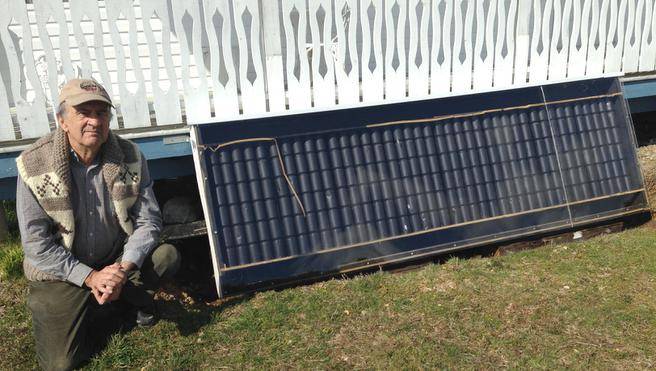Like this article? rabble is reader-supported journalism. Chip in to keep stories like these coming.
I got fed up waiting for solar energy to show up, so I made my own. You can see it in the photo. Works like a charm.
If a half-baked handyman like myself can get this going, that should tell you something.
First, about solar. Last year the world invested more in it than in coal and gas-fired electricity combined.
The big players — the U.S. and China — are doubling and tripling their installations within a year or two.
In hot countries like India, where solar is now cheaper than coal-fired electricity, deserts are blooming with solar-power facilities.
But that’s just the main form of solar — the kind that produces electricity, the technology of which is improving at light speed, bringing costs down. It feeds power grids, through huge installations, or just charges batteries for small uses that are proliferating constantly.
There’s also the kind that you see mainly on rooftops, which collects heat in black pipes filled with antifreeze — mainly for domestic hot water, but sometimes to augment hot water space-heating systems.
Then there’s mine — the low-tech version. It pumps hot air into the house when the sun is shining.
The heat engine is made of aluminum pop cans (aluminum is an especially good conductor) with the ends cut out, glued together with high-temperature silicone and painted black with stove paint.
A four-inch cold-air pipe feeds air from the basement into a bottom corner of the unit, driven by an in-line fan (Home Hardware, $40).
Heated air blows it back into the house via a hot-air pipe in the upper corner of the unit, opposite the cold air one.
The pop-can idea was actually pioneered in Atlantic Canada by one Jim Meany of Spaniard’s Bay, N.L., west of St. John’s. His Cansolair Inc.’s “solar furnace” is touted as the best of its kind in the world and is used for industrial and agricultural drying, as well as for home heating.
When I moved from the Dartmouth area to Yarmouth County in 2002, I had planned to get one, thinking it would be for sale soon locally. Thirteen years later it was nowhere near, an indication of how slack we are on this. So last year I drove to Bridgewater, the nearest dealer, and got one. It cost some $3,000 (minus a $500 provincial rebate). It was a beautiful machine, and no doubt far more efficient than my homemade rig.
Alas, when I got home I realized I couldn’t make it work because of my veranda overhang. I took it back. When I did, I asked the salesman how they were selling. OK, he said. But he also complained that “people are making their own.”
So I’m no pioneer. In fact, if you Google “DIY (for do-it-yourself) solar panels” you’ll find it going on all over North America, including instructions on how to do it.
The point of doing it myself, however, was that I could shape it to my available space. The Cansolair comes in only one shape. I made a long one (10 feet by 40 inches), sank it in a knee-deep trench and piped it under the veranda.
The frame is two-by-six planking with a backing of half-inch plywood, plus an inch of Styrofoam insulation in the back.
Inside the unit, a top and bottom plywood header holds the columns of pop cans in place, leaving enough space top and bottom for the in-and out-pipes and for air to feed under and over the cans. The unit is covered with five-mm Plexiglas.
Since this is mostly trial and error, the draggy line you see in the picture is one of my errors. Weatherstripping is needed between the Plexiglas and the wood. I used glue-on foam weatherstripping. The heat melted the glue and is disintegrating the stuff itself. I’ll have to try something else for next year.
The most trying part of it was finding a snap disk switch — which is wired to the fan and turns the unit on when it heats up and off when it cools. I spent lots of time on the Internet (Google “solar panel snap disk switches”), finally finding one at Senasys Corp. that turns on at 30C and off at 18C.
Another bit of advice. That stove paint (use the paint-on, not the spray) has an odour for a long time. Give it a few months to dry.
The point of all this is not merely to suggest that you can make your own, but, if it were ever to take off, local handymen and contractors could do it, designing them to fit whatever space the customer has, for perhaps little more than $500.
Already some outfits in the U.S. are manufacturing prefab parts.
And to answer your questions: 1) it cost me about $300, with the Plexiglas accounting for about half. And 2) I estimate it relieved my regular heating by about a quarter.
This despite two drawbacks. First, a sunny winter day with northwest winds is usually a partly cloudy day here in Western Nova Scotia. It will likely be better elsewhere. And my mucked-up weatherstripping caused it to lose efficiency.
Keep in mind that Nova Scotia is on the same latitude as southern France, so the “solar regime” is good.
Further, if we’re ever to get off the climatic road to nowhere, stuff like this will be necessary.
Ralph Surette is a freelance journalist in Yarmouth County. This article was first published in the Chronicle Herald.
Like this article? rabble is reader-supported journalism. Chip in to keep stories like these coming.




